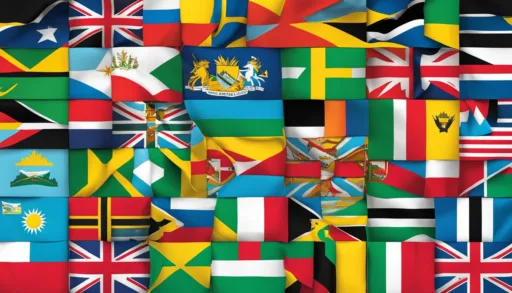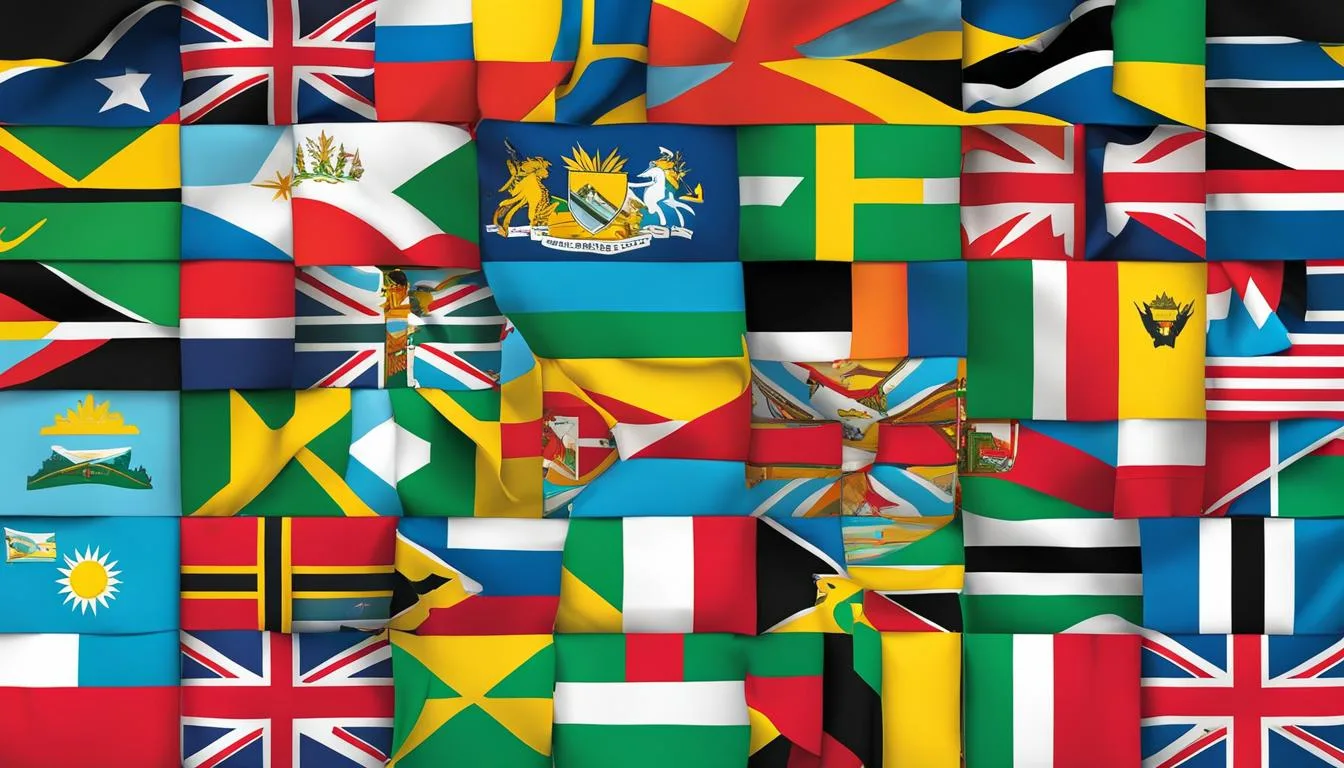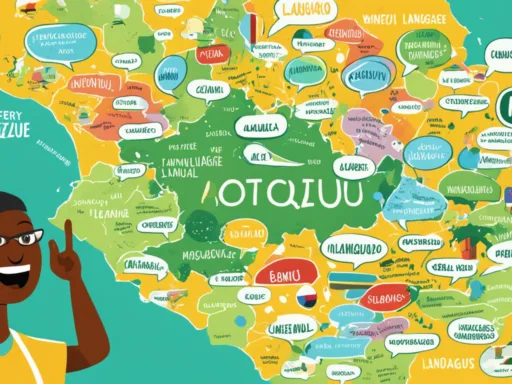With its pristine beaches and tropical allure, The Bahamas is often associated with vacation paradise, but did you know that there’s more to its charm than stunning scenery? Beyond the usual tourist experience, the Bahamian language diversity paints a vivid picture of cultural richness. While the official languages Bahamas boasts is English, the islands echo with more than just this global tongue. Locals often converse in Bahamian Creole, reflecting a unique cultural blend, and an astonishing 25% of the population speaks Haitian Creole, adding to the vibrant tapestry of languages spoken The Bahamas.
Understanding the linguistic nuances of The Bahamas is not just about appreciating its beauty but about embracing the multifaceted identity of this archipelago. This linguistic plurality not only shapes daily communication but embodies the islands’ storied past and diverse community life.
Key Takeaways
- English serves as the foundation for official communication and education in The Bahamas.
- Bahamian Creole, an English-based creole language, signifies the cultural fusion inherent to the islands.
- Haitian Creole’s prevalence highlights significant historical and ongoing immigration influences.
- The language diversity in The Bahamas reflects its rich cultural heritage and complex history.
- Diving into the local languages gives a deeper understanding of and appreciation for the Bahamian people and their way of life.
A Dive into The Bahamas’ Official Language: English
The rich tapestry of language diversity in The Bahamas is prominently marked by the predominance of English, a linguistic thread weaving through the country’s history and society. Delving into the official languages Bahamas attribute underscores the pervasive influence of English, while the subtleties of local dialects reflect the unique linguistic diversity in The Bahamas.
The History and Influence of English in The Bahamas
The adoption of English in The Bahamas traces back to the 1700s with the arrival of British colonizers. Over the centuries, as The Bahamas declared itself a British protectorate, English unsurprisingly was instituted as the official language. This period laid the foundation for English to flourish across the archipelago, deeply embedding British linguistic traits into the everyday lives of the Bahamian people.
However, the version of English that developed in The Bahamas was not stagnated. Through a fusion with African linguistic customs brought by slaves, English metamorphosed into what is today known as Bahamian English. This evolution illustrates the dynamism of language and the intersection of cultural influences, painting a portrait of linguistic diversity in The Bahamas that continues to evolve.
Understanding English Variations in Government and Education
Despite the colloquial shifts and the emergence of Bahamian English, British English persistently maintains its status in formal arenas such as government and education. This endurance is a nod to the historical ties and the importance of maintaining a standardized form for official procedures and academia. The seamless navigation between these English variations by Bahamians is a testament to the deep-rooted bilingual, or even multilingual, capacity stimulated by the country’s language diversity.
As we continue our exploration, it becomes clear that the landscape of language in The Bahamas is intricately layered. The presence of English in its multiple forms not only serves functional purposes but also ties the modern-day islands to their colonial past, all the while contributing to a unique linguistic identity.
The Vibrant Vernacular: Bahamian Creole
Bahamian Creole stands as one of the main spoken languages in The Bahamas, offering a window into the rich tapestry of cultural languages of The Bahamas. A captivating dialect that is integral to Bahamian identity, this language paints a picture of the islands’ diverse heritage, echoing the rhythms and patterns of the past.

The Blend of British English and African Influences
Woven into the very fabric of Bahamian society, Bahamian Creole is a linguistic amalgam of British colonial history and the African descent of many of its speakers. While the grammar and vocabulary are anchored in English, the rhythm and cadence flow from West Africa, creating a dialect that is uniquely Bahamian.
Common Phonological Features of Bahamian Creole
Distinguished by its phonology, Bahamian Creole is characterized by notable variations that set it apart from other English-based creoles. It is rich with nuances, such as the deletion or addition of the /h/ in speech and the pin-pen merger, which adds to its distinctiveness and demonstrates the linguistic versatility present in The Bahamas.
Unveiling the Presence of Haitian Creole in The Bahamas
The matrix of Bahamian language diversity is nuanced by the significant Haitian community, infusing linguistic diversity in The Bahamas with the vibrant tones of Haitian Creole. Spoken by a considerable slice of the populace, this language harbors a rich lexicon and an assortment of syntactic features that differentiate it distinctly from the local Bahamian Creole.
Haitian Creole embodies a unique foothold in The Bahamas, originating from a completely different language family. The French roots of Haitian Creole are embellished with influences from several other languages, manifesting in a dialect that stands apart in its rhythm and structure from the English-based creoles of the Caribbean.
| Feature | Bahamian Creole | Haitian Creole |
|---|---|---|
| Language Family | English-based Creole | French-based Creole |
| Main Influences | African Languages, British English | French, Taino, Spanish, English, West African Languages |
| Phonology | Non-rhotic, ‘Happy’ vowel variations | Nasal vowels, French phonetics |
| Sociolinguistic Role | Vernacular speech amongst locals | Communication within Haitian communities |
The presence of Haitian Creole within The Bahamas is not merely a linguistic curiosity but a testament to the islands’ complex cultural history, having felt the ripples of the Atlantic slave trade and fostering an immigrant narrative. This language continues to thrive, fortifying the cultural and linguistic diversity in The Bahamas.
Languages spoken The Bahamas: A Reflection of Cultural Diversity
The beautiful mosaic of language diversity in The Bahamas is a testament to the rich tapestry of cultures that make up this vibrant archipelago. The two primary tongues, Bahamian English (often referred to as Bahamian Creole) and Haitian Creole, exemplify the elaborate interplay of historical influences and the melting pot nature of the islands.
Delving into the realm of Bahamian language diversity, these languages are not just means of communication but are deeply embedded in the nation’s identity, representing the myriad stories and backgrounds of its people. From the animated markets of Nassau to the serene beaches of the Out Islands, language is a colorful illustration of The Bahamas’ diverse society.
- Bahamian English: A Creolized form influenced by African dialects and British English.
- Haitian Creole: Originates from French, with a rich blend of African and Amerindian languages.
The intersection of these languages within the community fosters an environment where heritage and traditions are preserved and celebrated through the spoken word. The following table provides a clearer understanding of the linguistic components that contribute to the Bahamian identity.
| Language | Origin | Speakers | Notable Features |
|---|---|---|---|
| Bahamian English (Creole) | Afro-British | Majority of locals | Unique pronunciations and vocabulary |
| Haitian Creole | French-African | ~25% of the population | Includes Spanish, Taino, and English loanwords |
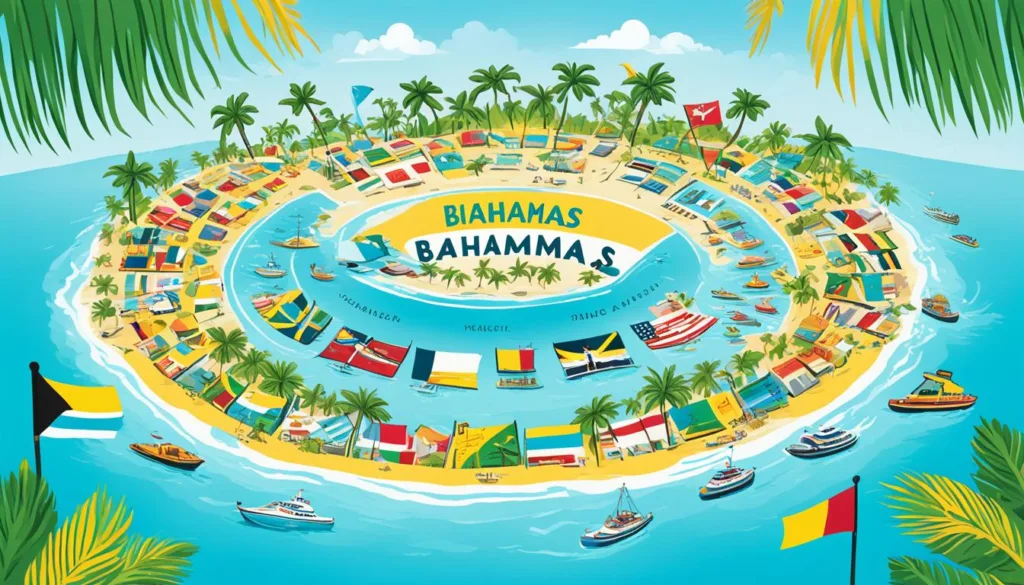
Indeed, The Bahamas is not just a destination for sun, sand, and sea, but also a hub of linguistic and cultural exchange—a place where language both shapes and reflects the diverse spectrum of human experience.
Deciphering the Differences: British English vs Bahamian English
The linguistic landscape of The Bahamas is a vibrant tapestry, rich with history and cultural influence. The official languages of the Bahamas encompass a spectrum, with British English as the base and Bahamian English as a local adaptation, reflecting the country’s colonial past and its Bahamian language diversity. The distinction between these two forms of English is not just an academic one; it is laden with the history and heart of the Bahamian people. To better understand these differences, a comparison is key.
| Feature | British English | Bahamian English |
|---|---|---|
| Pronunciation | Non-rhotic, clear enunciation | Non-rhotic, with a tendency to drop ‘h’ sounds |
| Spelling | Follows traditional British norms (e.g., colour, theatre) | Similar to British but affected by American media influence |
| Grammar | Strict adherence to established grammatical rules | Simplification of some rules; unique tense and aspect usage |
| Vocabulary | Retains words of French and Latin origin | Includes African and Caribbean terms alongside British English words |
| Idiomatic Expressions | Rich in historic and formal idioms | Includes colorful local expressions reflecting culture and traditions |
While British English remains the standard in more formal settings such as legal and academic fields, Bahamian English is infused with a more laid-back, rhythmic tone, indicative of island life and the African influences that have shaped it. This brings forth a language variety that resonates with both the history and ongoing narrative of The Bahamas.
As one delves into the roots of Bahamian linguistic expression, it becomes apparent that the language is not just a means of communication, but a celebration of the nation’s journey—from past to present, from colony to a beacon of culture and diversity.
To experience the depth of Bahamian language diversity is to understand the soul of The Bahamas. It’s a melodic dialect that sings the songs of its ancestors while embracing the nuances of modern expressions. Whether it’s in the official domains that still hold fast to British linguistic traditions or the streets where Bahamian English thrives, the language remains a testament to an identity wholly its own.
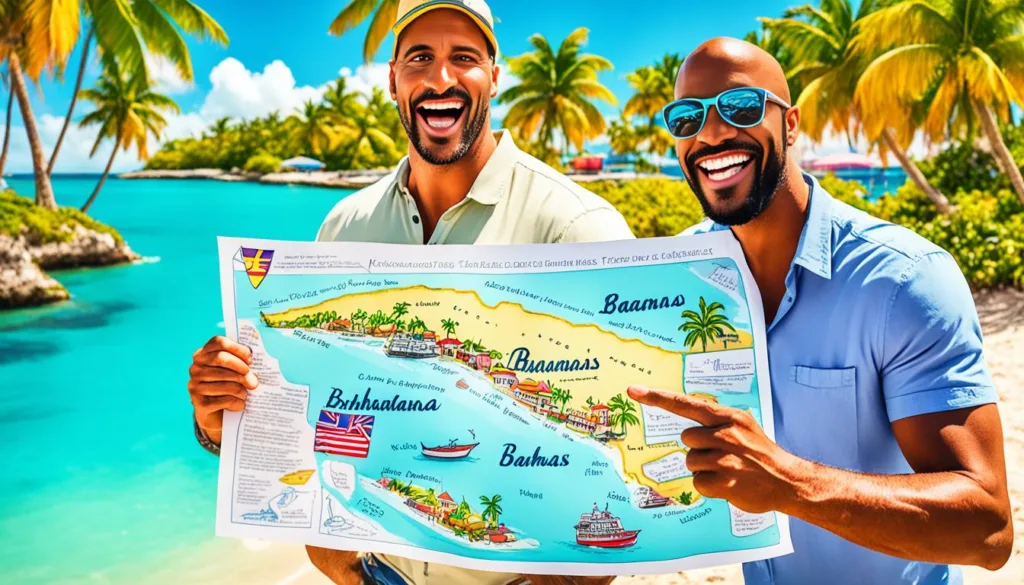
Bahamian Creole: Language or Dialect?
The debate surrounding Bahamian Creole—a cornerstone among the cultural languages of The Bahamas—continues to intrigue linguistics scholars and language enthusiasts alike. Hanging between the definitions of language and dialect, it is a vibrant representation of Bahamian language diversity, marrying British colonial influences with African linguistic traditions. Its standing as a fully-fledged language system or a variant of English encapsulates the richness of Bahamian identity and history.
In an attempt to delineate the complex nature of Bahamian Creole, we encounter a linguistic puzzle that remains dynamic and nuanced. While rooted in English, Bahamian Creole constitutes a grammar and lexicon that is undoubtedly its own, raising the question of whether it should be held akin to a dialect or esteemed as a language in its own right. This linguistic entity challenges our concepts of language hierarchies and promotes a discussion on the validity of every form of verbal expression.
| Features | Bahamian Creole | Standard British English |
|---|---|---|
| Grammar | Distinct from Standard English | Structured according to traditional rules |
| Vocabulary | Unique words and phrases | Standardized lexicon |
| Phonology | Unique pronunciation patterns | Conservative pronunciation standards |
| Social Perception | Often considered informal or colloquial | Viewed as official and formal |
| Use in Culture | Integral to Bahamian cultural expression | Official use in governmental and educational settings |
The exploration of Bahamian Creole does not stop at academic forums. Rather, it spills into the streets, homes, and hearts of the Bahamian people, who instinctively navigate the nuances of this linguistic form. As the debate on its classification unfolds, it becomes clear that language is more than a set of grammatical rules—it is the living pulse of a people’s heritage and identity.
Nuances in Bahamian Pronunciation and Grammar
As one of the main spoken languages in The Bahamas, Bahamian Creole showcases a captivating variety of pronunciation and grammar that contributes to the Bahamian language diversity. Its nuances provide insight into the island’s rich linguistic tapestry.
Interesting Pronunciation Patterns in Bahamian Speech
Bahamian pronunciation is distinct and hints at the language’s evolution over time. Vowel mergers, for example, are common, where words like ‘pin’ and ‘pen’ might sound indistinguishable. Another notable feature is the non-rhotic pronunciation, often identified by the absence of the /r/ sound, especially at the end of words or before consonants. This leads to a unique rhythm and melody in spoken Bahamian Creole that stands apart from Standard English accents.
Grammatical Distinctions in Bahamian Creole
The grammar of Bahamian Creole differs significantly from Standard English as well. It simplifies some of the English language’s complex consonant clusters, making it more streamlined in certain respects. Moreover, the creole manifests its own set of rules when it comes to tense and aspect, pioneering conventions that are not present in traditional English. These grammatical signatures underscore the cultural and linguistic individuality found in The Bahamas.
| Feature | Description | Example in Standard English | Example in Bahamian Creole |
|---|---|---|---|
| Vowel Mergers | Tendency of vowels to sound alike | Pin vs. Pen | Pin = Pen |
| Non-rhoticity | Silent ‘r’ in certain environments | Car, Farther | Ca, Fahtha |
| Consonant Cluster Simplification | Reduction of complex consonant groups | Asked, Hands | Ask, Han’s |
| Tense and Aspect | Unique patterns of expressing time | I have seen, I was running | I done see, I runnin’ |
The unique linguistic patterns of Bahamian Creole offer a window into the soul of The Bahamas, highlighting the importance of honoring and preserving the island’s language diversity. Whether through vowel mergers or grammatical innovations, the speech here continues to be an integral part of the Bahamian cultural identity.
Haitian Creole: A Distinct Language Among The Bahamas Population
The tapestry of cultural languages of The Bahamas is rich and varied, with Haitian Creole as a strikingly colorful thread. Unique in its lexicon and grammatical structure, Haitian Creole has established itself as an essential part of the linguistic diversity in The Bahamas. A testament to the island’s rich cultural exchange, it continues to be a primary mode of communication for the Haitian community living in The Bahamas, seamlessly weaving into the nation’s cultural fabric.
In understanding this language’s vital role, we can dive deeper into its distinguishing features:
- The influence of French vocabulary and syntax amidst African, Taino, Spanish, and English elements.
- A pronunciation system that’s distinct from either French or English.
- An embodiment of the Haitian diaspora’s history and resilience.
The following table illustrates some key comparisons between Haitian Creole and Bahamian English, highlighting the rich linguistic diversity within The Bahamas.
| Feature | Haitian Creole | Bahamian English |
|---|---|---|
| Lexical Origin | French-based | English-based |
| Grammatical Structure | Simpler tense and aspect system | More complex, close to Standard English |
| Phonetic System | Non-rhotic, nasal sounds common | Rhotic, with vowel merges like the pin-pen merger |
| Use in The Bahamas | Primary language among the Haitian community | Widely used in informal and casual contexts |
| Cultural Significance | Reflects the resilience of Haitian immigrants | Encapsulates the distinctive Bahamian identity |
Haitian Creole’s presence in The Bahamas not only enhances the archipelago’s cultural languages, but also promotes an inclusive understanding of the various narratives that comprise the nation’s history. It is an essential part of the Bahamian society, supporting its reputation as a melting pot of cultures and languages.
Language Aids and Dictionaries for Bahamian Dialects
Delving into the official languages of The Bahamas unveils a captivating world of linguistic diversity, with Bahamian Creole and Haitian Creole holding a special place in the nation’s cultural fabric. To truly appreciate and learn these main spoken languages in The Bahamas, various resources have been meticulously crafted to assist learners and scholars alike. These tools not only capture the essence of the spoken word but also serve as conduits for preserving the vibrant linguistic traditions of this Caribbean paradise.
Important Resources for Understanding Bahamian Creole
As a cornerstone of Bahamian heritage, the unique vernacular of Bahamian Creole forms an integral aspect of daily communication and identity. Curious minds seeking to grasp this dialect will find the ‘Dictionary of Bahamian English’ as an invaluable compendium, offering a comprehensive look into the richness of local vocabulary and expressions. In addition, the ‘Bahamian Creole Grammar’ provides an in-depth exploration of the language’s structural intricacies, guiding learners through the maze of its syntax and phonetics.
Online Tools and Dictionaries for Bahamian and Haitian Creoles
In today’s digital world, the quest for understanding extends into the virtual realm, where online platforms present readily accessible information about Bahamian and Haitian Creoles. These internet-based dictionaries and learning aids cater to a global audience, enabling anyone from language enthusiasts to tourists to familiarize themselves with the fascinating linguistic landscapes of The Bahamas. For anyone eager to converse in or comprehend these unique dialects, these tools are just a click away, bringing the melodious rhythms of Bahamian tongues right to your fingertips.
FAQ
What languages are spoken in The Bahamas?
The Bahamas primarily speaks English, which is the official language. However, Bahamian Creole, an English-based creole language, is also widely spoken across the islands. Additionally, Haitian Creole is spoken by a significant part of the population, particularly those of Haitian descent.
How has English influenced The Bahamas?
English, introduced by the British in the 1700s, has been the official language and remains a cornerstone for government, education, business, and media in The Bahamas. Over time, it has evolved to include local dialects and African influences, resulting in the unique Bahamian English.
What variations of English are used in Bahamian government and education?
In government and educational settings, British English is standard, reflecting The Bahamas’ colonial history. Nevertheless, Bahamian English, which includes local idiomatic expressions and pronunciations, is also understood and used informally.
What are some common features of Bahamian Creole?
Bahamian Creole is characterized by a blend of British English and African influences, with unique phonological features such as dropping the /h/ sound, hypercorrection, and the pin-pen merger. Its syntax and vocabulary also set it apart from Standard English.
What is the Haitian Creole language in Bahamian society?
Haitian Creole is a French-based creole language, influenced by various other languages. It is the primary language for the Haitian community in The Bahamas, representing about 25% of the population, and adds to the linguistic diversity of the nation.
How does cultural diversity impact language in The Bahamas?
The Bahamas’ cultural diversity, with its mix of native Bahamians, British colonial history, African heritage, and Haitian diaspora, directly influences its linguistic variety. This diversity is reflected in the use of different languages and dialects within the archipelago.
Are there notable differences between British English and Bahamian English?
Yes, while based on British English, Bahamian English has evolved distinctive expressions and pronunciations. It maintains some British norms but has been shaped by the islands’ unique culture and African linguistic heritage, which creates a rich and dynamic version specific to The Bahamas.
Is Bahamian Creole considered a language or a dialect?
Bahamian Creole is often at the center of linguistic discussions regarding its status as a language or a dialect. It is a creole language with its own syntax, grammar, and vocabulary rules, reflecting a synthesis of languages and cultural influences present in The Bahamas.
What are some interesting pronunciation patterns in Bahamian speech?
Bahamian speech is known for its vowel mergers, the dropping of the /h/ sound or hypercorrection of it, and the tendency not to pronounce /r/ at the ends of words or before consonants. These features contribute to the distinctive sound of Bahamian Creole.
What distinguishes Haitian Creole from other languages in The Bahamas?
Haitian Creole differs significantly from Bahamian Creole and English. It has a unique vocabulary and grammatical structure heavily influenced by French, and it includes elements from Spanish, English, Taino, and West African languages, akin to Haiti’s diverse cultural roots.
Where can I find resources to learn more about Bahamian Creole and Haitian Creole?
There are various resources available for those interested in learning about Bahamian and Haitian Creoles, including dictionaries like ‘Dictionary of Bahamian English’ and grammar guides like ‘Bahamian Creole Grammar’. Additionally, there are online platforms that provide information, vocabulary lists, and insights into the grammatical structure of these languages.
